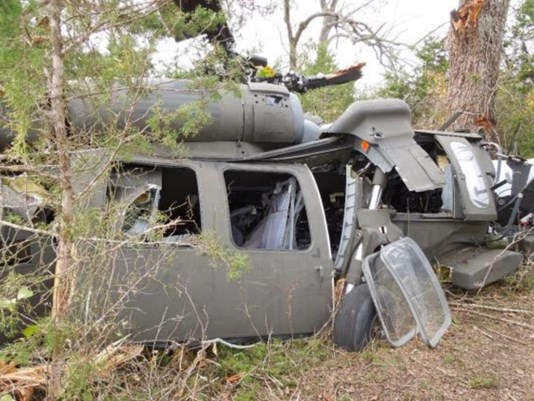Channel Six News has obtained a copy of the 15-6 internal investigation into the November 2015 Black Hawk helicopter crash that killed four army aviators from Fort Hood.
According to an army memorandum, the UH-60 Black Hawk chopper was supposed to conduct a "low risk" training flight that would take it from Hood Army Airfield (HAAF) through a local training area and to the Temple airport, where it would stop before returning back to HAAF. The helicopter departed Fort Hood around 5:00 p.m. on Nov. 23.
Shortly into the flight, a night supervisor took control of flight operations, where he could view a high-tech tracking system. Four minutes into his shift, the UH-60 chopper disappeared from radar. It is believed to have crashed sometime around 5:26 p.m.
"Due to timing discrepancies between the cockpit voice recorder, the flight data recorder, and local time, there is no way to pinpoint the actual time of the crash with certainty," the investigation states.
The army investigation determined that weather did not contribute to the accident. However, investigators do believe that the sunset would have made it difficult for the flight crew to "detect and avoid obstacles" as they flew west -- in the direction of the sun -- at a low altitude.
The crash occurred during a second "break turn" maneuver conducted by the crew at 138 miles per hour and just 300 feet above the ground. In the assessment of investigators, the crew did not have enough altitude to recover from what was intended to be a 60 degree bank angle during the maneuver. Additional analysis later determined the aircraft actually reached a bank angle of more than 70 degrees -- well above the maximum bank angle of 60 degrees. The helicopter then stalled.
While communication is common between crew members during similar maneuvers, the cockpit voice flight data recorder shows a lack of communication between the pilots and crew chiefs leading up to the crash.
Investigators determined the entire crew was properly trained and well-rested prior to the flight. Drug screenings were conducted after their deaths. But, while at least one toxicology screening came back negative, a partially-redacted portion of the report implies not all results were available.
"...we therefore cannot make a finding as to whether they had any controlled substances in their system at the time of the accident," the investigation states.
The investigation suggests there were no mechanical failures, and evidence indicates that all mechanical safety precautions were followed ahead of the training flight. Maintenance records were determined to be in compliance, and there were no overdue inspections.
Even so, investigators found ground procedures for missing aircrafts were inadequate. In the months since the crash, the procedures for overdue aircrafts have been adjusted to better deal with another crash.
"The fact that it took over two and a half hours after the overdue aircraft was declared before notifying Search and Rescue (SAR) lends credence to the overall atmosphere of complacency and lack of sense of urgency when an overdue aircraft is declared," the investigation states.
However, investigators also determined the crew did not survive the impact, so a different response on the ground would not have saved lives, according to the report.
Investigators have written a list of recommendations for the future. Those include reviewing overdue aircraft procedures, conducting frequent pre-accident plan rehearsals and setting a minimum altitude for doing similar combat training maneuvers.


